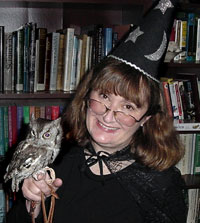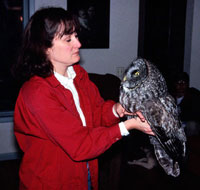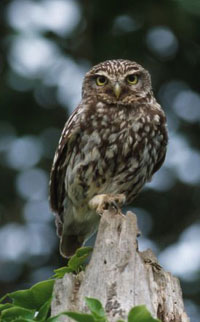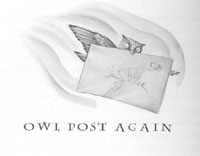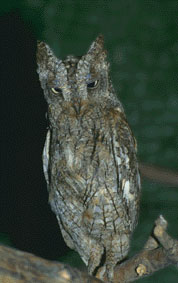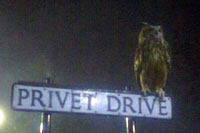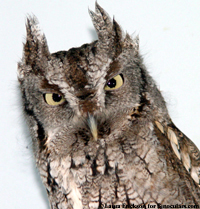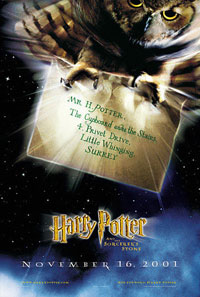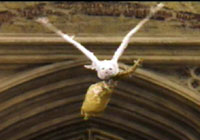By Laura Erickson(a.k.a. "Professor McGonagowl") (SPOILER discussion of Hedwig in Book 7--Harry Potter and the Deathly Hallows--is here.) No spoilers beyond this point: Now that five Harry Potter movies and all seven books have been released, people have become very familiar with owls. This website will give you facts about owls both in the real world and in J.K. Rowling's magical world. I live in the United States, but Harry Potter lives in England. Some owls live in both places, and some are found on only one side of the pond. I've studied owls for a long time and read all seven Harry Potter books and seen the movies, but I simply couldn't have written this and made it authoritative without a lot of help from a lot of people. If you have information I should add, corrections, or other comments, please email me. In J.K. Rowling's wonderful universe, owls bridge the magical and muggle world, carrying messages, packages, and even Nimbus 2000s with ease as they make it clear to muggles that when a message needs to get through, it WILL get through. One Snowy Owl named Hedwig also provides warm companionship when a lonely wizard named Harry needs it. If you have questions about owls, first look to see if you can find the answers here. If not, you can email Professor McGonagowl. As always, if you have questions, comments, or corrections, please let me know. To get more information, see:
Hedwig
Harry's owl Hedwig is a Snowy Owl. She's a female but, in the movie, the actors playing her are males. (One of the owls playing Hedwig was also the very first cast member to be chosen!!) You can tell that the owl playing Hedwig in the photo is really a male because his plumage is so white--female Snowy Owls have dark markings. Females are also bigger and heavier, and so would be a little harder for human actors to handle. Healthy males average about 4 pounds, females almost 4 1/2 pounds. They have powerful talons. You can't see in the photo that Daniel Radcliffe is wearing thick leather protection on his arm. Claws that can kill a large duck through thick feathers can be pretty hard on human arms, too, even when the owl is just trying to balance itself. Seven different owls played the role of Hedwig. Their names are Gizmo, Kasper, Oops, Swoops, Oh Oh, Elmo and Bandit. I found out some interesting things on The Pet Place site about Harry Potter. Real Snowy Owls live in the arctic tundra, in North America, Europe, and Asia. A few breed in the northern British Isles. Long ago, when the Arctic climate extended farther south than now, Snowy Owls lived much farther south. Cave art by Paleolithic people of Europe includes an etched outline of two Snowy Owls and their chicks on a cave wall in Ariege, France. This particular prehistoric drawing happens to make the Snowy Owl the first recognizeable bird species to be depicted in art anywhere in the world. Snowy Owls are predators, and eat only animals, never plants. Their main prey species is the lemming, a fierce little rodent smaller than a chipmunk. Lemmings have enormous population fluctuations from one year to the next. When lemmings are abundant, Snowy Owls may eat hardly anything else. They usually swallow each lemming whole, head first, but if they're not too hungry, they sometimes bite off just the head, or even eat parts in small bits. But when lemming numbers are down, Snowy Owls eat a lot of other things. Depending on where they live, they may eat a lot of snowshoe hares, grebes and ducks (especially Horned Grebes), ptarmigans, ground squirrels, rats, partridge, and even fish. When a Snowy Owl's face gets gooped up with blood and guts, it sometimes cleans up by wiping its face in the snow. I have a couple of photos of wild Snowy Owls on my Snowy Owl Bird Photo Gallery. Global warming is expected to hurt Snowy Owls over much of their range. Hedwig is lucky she lives in a magical world! Errol
The Weasley family has a very clumsy owl named Errol. In the movies he's a Great Gray Owl. I don't think his species is actually mentioned in the books, but my friend Katty from Belgium found that he IS called a Great Gray Owl on J.K.Rowling's Web site. Measured from head to tail, the Great Gray Owl is the biggest owl in the world. But even though they're an inch or so longer than Snowy Owls and look just as big, they weigh much less than Snowy Owls--sometimes less than half! Also, their wingspan isn't as long as that of Snowy Owls, probably because their wings don't carry nearly as much weight. Great Gray Owls specialize on mice and voles, and have very thin toes compared to other huge owls. In North America, wild Great Gray Owls live in Alaska and much of Canada down to northeastern Minnesota, and down into the mountainous areas of Washington, Oregon, California, Idaho, Montana, and Wyoming. In Europe and Asia, they are found in northern Scandinavia, Russia, Siberia, northern Mongolia, Northern Manchuria, Amurland, and Sakhalin. They make it to Great Britain only in the magical world of Harry Potter. Real Great Gray Owls cannot carry very heavy items because they themselves are so light (usually less than 3 pounds!), and their feet are fairly weak. When I was taking care of injured birds, I once had to go rescue a Great Gray Owl that I then transferred to a raptor specialist. I had it for a little while, and was amazed at how innocuous its feet were. I normally took care of songbirds, so didn't have the heavy gloves normally worn when doing raptor work, but this owl's talons didn't hurt my bare hands at all. Normally over 90% of a Great Gray Owl's diet is one species--meadow voles. When they eat larger prey, such as rabbits and squirrels, they must sit on the animal for many hours, biting off small chunks of meat. The Weasley's Great Gray Owl, Errol, is very clumsy. Real owls simply cannot crash the way Errol does in the movie. Not even the owl actor who plays Errol could really crash like that--like other birds, owls have hollow bones and are much too fragile to slam into tables and windows. In the movie, they filmed a real Great Gray Owl flying gracefully through the Errol scenes. Then they substituted a dummy owl for the crashes. You can see many photos of wild Great Gray Owls at my Great Gray Owl Bird Photo Gallery. Pigwidgeon
Pigwidgeon is so minute that some people have suggested to me that he might be a Little Owl, one very small owl found in England. This owl's scientific name is Athene noctua, and it is fairly common in much of its range, in southern and central Europe and Asia, and northern Africa. Little Owls aren't native to England, but were introduced there in the late 1800s. Little Owls are not found anywhere naturally in North America, but they are in the same genus, and closely related to, the Burrowing Owl. Like the Burrowing Owl, the Little Owl is found in open habitats, and is often active in the daytime as well as the night. The Little Owl often perches on posts and other look-outs. Like most tiny owls, the Little Owl eats many insects, which it can catch on the wing. The Little Owl does have some interesting mythology of its own, being the sacred owl of the goddess Athene--that's how it got its scientific name. And it is shown on coins from ancient Athens. But according to J.K. Rowling's own website, and supported by Mary Grandpre's lovely illustration in Chapter 22 of Harry Potter and the Prisoner of Azkaban, Pigwidgeon is a Eurasian (Common) Scops Owl. This owl, even tinier than a Little Owl and more closely related to the Screech Owls of America, has "ear tufts"--feathers that stick up on the head and look like ears. The owl illustration for this chapter clearly shows those feather tufts. We hope the moviemakers use a scops owl when Pigwidgeon finally appears--he wasn't in the third or fourth movies at all, which has been a big disappointment to me and many others!
Ron seemed resentful to have such a tiny animal compared to Harry's Hedwig. But we bet he didn't have to work nearly as hard to clean up after Pigwidgeon as Harry did for Hedwig! Owl poop is smelly and messy. (Unless they're magical owls--we notice that Harry's black cloak never has a single white spot on it!) Malfoy's Owl
Malfoy's owl is the largest, heaviest owl in Europe, an Eagle Owl. Eagle Owls are not found in the United States--they live in Europe and Asia. Eagle Owls are not native to Great Britain, but a few pairs have escaped captivity. Scientists hope they don't become established in the wild in England because like all introduced animals, they will almost assuredly disturb the balance of nature already there. But in their native range these magnificent birds are an important part of that balance. Eagle Owls have oranger eyes than Great Horned Owls, are slightly larger, and have heavy, vertical streaks on the front, rather than the finer, horizontal barring of the Great Horned Owl. Again, notice how it perches with the two normal front toes facing forward. (The "thumb" toe and the back toe face backward). Percy's Screech Owl
I didn't pay enough attention to another owl--Percy's! Fortunately, my friend Katty writes:
Other Owls Appearing Here and There
Throughout the Harry Potter movies, there are lots of owls here and there. The owl shown in many of the posters, screensaver, and other promotional material for the movie, Harry Potter and the Sorcerer's Stone, is a Great Horned Owl. This owl lives in North, Central, and South America, but is not found in the wild in England or any other place on that side of the Atlantic Ocean. I don't know if this promotional material was used in England, but it makes a lot of sense for an American owl to deliver invitations to the movie to people in Canada and the U.S. Notice that the owl has two front claws on each foot facing forward. Owls have three front toes and one back toe on each foot. But one of the front claws is opposable, and rotates backward the way we use our thumb. So the way this owl is carrying the letter to Harry is, indeed, exactly the way a real owl would carry mail. Notice that owls prefer air mail.
In real life, large species of owls sometimes eat smaller species. Real owls are extremely stressed by being near other owls. But filming the scene on the left did not stress the owls. Why? This scene was filmed over and over, with different owls each time, and then the films were digitally manipulated to make it appear that all the owls were there together at the same time.
Notes about the fourth movie: My friend Katty from Belgium, who is blind so notices a great many sounds I don't pay enough attention to, writes:
Frequently Asked Questions
Could a real owl really carry a Nimbus 2000? I weighed one corn broom as 0.6 kilograms. Snowy Owl often kill snowshoe hares and can carry them to their nestlings. A snowshoe hare weighs over 1 kilogram, so the weight of a real broom wouldn't be a problem for a Snowy Owl. And a Snowy Owl's talons can easily grip a broom handle. So yes, a real Snowy Owl could really carry a Nimbus 2000. But the Snowy Owl in this scene simply flew through, and then the filmmakers digitally added the broom. This wasn't too hard to do. In the arctic tundra, where there are no trees for Snowy Owls to bonk into in flight, they often dangle their legs in flight. So in this scene, the real owl's legs are already in position to be carrying something. Tiny owls can easily carry mice, so letters and birthday greetings would be quite easy for them to manage. But according to The Pet Place, "Although throughout the movie, it appears the owls carry messages and even the broom, they didn’t actually hold the objects. Instead, they were attached to the birds using an invisible harness. When they reached the right point, a trainer pulled a cord, which released the message or object." Also, notice that the broom that was delivered in the movie was really made out of paper. Can real owls be happy in cages? The cage Harry often keeps Hedwig in is way too small for any real owl, and the tiny Victorian cage used in the movie would be illegal to keep an owl in in either the U.S. or Great Britain. Great Britain requires all bird cages to be big enough to allow the bird to stretch its wings fully without touching anything. To keep it in anything smaller requires a veterinary certificate. But the owl playing Hedwig is probably used to a fairly small cage when he goes places, the way dogs or cats get used to a small pet carrier or kennel, as long as they don't need to stay in it too long or too often. Are real owls ever active in the daytime?
My own little owl, Archimedes, reminds me of a cat. He's active when he feels like it and sleeps when he feels like it, day or night. Screech Owls roost and nest in tree cavities or nest boxes, and are very vulnerable to jays, robins,and crows in the daytime, but they need some sunshine to produce Vitamin D, so they spend much of the day with their head poking out of the hole. If a cranky robin or jay spots one, the little owl just retreats back into the cavity. Can people really have owls for pets? In
the magical world of Harry Potter, a wizard or witch can own
a real owl. In the real world, in England, people are allowed
to keep owls provided the bird can be shown to be captive bred
or found disabled and unable to be returned to the wild--in
order to show owls for money or to breed them for sale, people
in the U.K. need to have what is known as an "Article
10 certificate," which functions much as a licence for
the bird. How can I see a real, live owl in the wild? Find out if your town or city has an Audubon society or other bird club. Most bird clubs have field trips, and will have experts along to help you see all the birds. And they might have some special trips just to find owls! How can I help owls?
|

